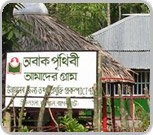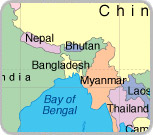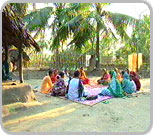User:Amader gram
Contents
Amader gram
Background information
The Amader Gram is an innovative project and as a social innovation first of its kind in the country. Through this project there is a formal way of collecting, preserving and even re-sourcing data on so many things both in respect of project's own activities and beyond, instead of letting thousands of everyday data get lost. On the contrary, the Statistical Department of Government does not have any regular mechanism to collect/preserve data on our villages. Of course, in some of the upazila (sub-district), Government has branches of the Statistical department with only one officer (remain absent most of the time) and does not have any ICT facilities. So, introducing a formal/disciplined set-up of collecting and preserving data of the village society (as an on-going process), may be exemplary against the present mechanism of the government's data keeping way. Not only local data keeping, there are scopes of data generation also. Data is being collected and kept for its generation and uses. At the one hand the collected data is documenting the day-to-day changes in villagers' lives. On the other hand, the stored data will generate lot of many other data those can be used for the acceleration in further changing of the living status of the villagers. For example the data related to micro-credit activities is providing information on potential Income Generating Activity (IGA) sectors and on the ways of access to credit and other supports so that the entrepreneurs can take quick and appropriate steps for undertaking suitable projects. A database on credit provides information on the amount of credit installment, rate of interest, sources of credit, recovery procedure etc.- all those can help in breaking the deadlock and gain confidence towards micro-credit access for the silent majority.
Simultaneously the database on training (knowledge transfer) can be effective by providing information on training courses, trainers, training cost, and training resources –all those can contribute in growing up of a skilled human force within the rural community. We believe that skilled manpower is a pre-requisite for the successful implementation of income generating programs by utilizing any amount of credit. Training on leadership, group dynamism, accounts keeping, program monitoring, marketing are some of the identified area where people are yet to be developed on. Fair and uninterrupted access to credit and its proper utilization will create a large number of entrepreneurs, the number certainly contribute to the efforts of other development actors in GO-NGO sectors –who are working on the same cause in the same area.
Data linkages to the schools may need some elaboration. Because, not only the data on school going children, but also on the dropout children, their causes of being dropout and other socio-economic features will be stored. This storage can help to set-up future plan for the enrollment of dropouts and to choose the suitable education package (whether technical or non-technical) for them. If it is addressed properly, the dropout rates may be prevented which is very much part of the poverty reduction strategies of the country.
As for linkages of the information flow to local government , here it is important to mention that in “Amader Gram” project area BFES is not only the actor, there are other development actors like local government departments, local elected bodies, elite – all are working towards the same mission: Poverty Reduction. At Upazila level, there is a central development committee in which GO and NGOs are the partners and complementary to each other for the same cause. Now it is needed to blend all the stakeholders and ensure their participation.
The primary users of those data are the beneficiaries of ‘Amader Gram' project. In fact, they are the owners. Getting access to information and having the ownership, the beneficiaries have great privilege to monitor the other actors' role in reducing the poverty in the area. Beneficiaries (primary users) can help by giving regular feedback on the development activity progress, to central development committee and thus can help in the planning process and finding out a common strategy (by the stakeholders) towards poverty reduction in the area.
As well, while the beneficiaries are the primary users of the database, the government people, researchers, local leaders, teachers, religious leaders and other stakeholders may be the secondary users by which they can improve, rectify and upgrade themselves.
The above information on database activities to poverty reduction strategies is linked with their outcomes. A disciplined process of data collection and analysis on credit and skill development training widen the scopes of employment. Women, unemployed youth and seasonal workers can have options for employment . Availability of data will not only help by presenting the increasing number of ultra poor, but also prevent the poor class to become ultra poor. On the contrary, it will show some innovative means, ideas and technologies. (As for example, information on availability and variations of seeds and related technology may show a farmer new ways to utilize his fallow land or to cultivate additional crops after harvesting of normal crops. Data on marketing may help the farmers inspiring cultivation of year - round crops, develops selling centers, vegetable/fruit processing and many other agro-based initiatives). Those data will be effective to feed up different professional groups. Access to data base to different stakeholders will help formulating common plan basing on a common context analysis which will contribute to poverty reduction efforts, by avoiding duplications.
While the increasing unemployment is a vital cause of poverty, the skilled ICT users can increase the number of entrepreneurs by holding computer centers, either individual or group level, using the micro-credit support. A good number of skilled youth can start earning by selling training to the others and by doing repairing and trouble shooting job.
he ICT based education at village level is helping people to communicate independently and to get scopes of distance learning. This scope will improve the quality and accelerate the rate of education in the area.
- Breast Cancer Identifying & Treating Project
- Database Program
- Knowledge Center
- Literacy for Livelihood
- Monitoring and Evaluation
- Rural News Online
- Amader Gram Database program
|
How it comes into being?
The concept of the center was evolved as a new model for information retrieval and storage; knowledge acquisition and management at the grass root level and use those in the community development efforts. The data collected through Baseline Survey, on the beneficiaries' life was preserved as database in computer software. But the idea of setting up an Information center at rural level has been conceived when those data need to be updated, improved and need utilization. This has persuaded to set up knowledge and Information center in April 2001 in Bagerhat, (in South-west part of the country) as pilot basis. This Rural Information Center was designed to develop participatory monitoring and learning system at the village level. Accordingly, 10 Group leaders (women) have been trained to act as ISP/Focal points. Those trained persons are women group members and held responsible for data preservation, analysis and dissemination.
Our patnare
- Association for Progressive Communication
- Computer Aid International
- DFID
- International Breast Cancer Research Foundation
- Taneda Fund
- Japan Education Fund
- Government of Japan
- AusAid
- Swiss Agency for Development Cooperation
- Ministry of Science & ICT, Government of Bangladesh
- Commonwealth Educational Media Center for Asia
- UNESCO
- DFID Imfundo Knowledge Bank
- Global Knowledge Partnership (GKP)
How it comes into being
The concept of the center was evolved as a new model for information retrieval and storage; knowledge acquisition and management at the grass root level and use those in the community development efforts. The data collected through Baseline Survey, on the beneficiaries' life was preserved as database in computer software. But the idea of setting up an Information center at rural level has been conceived when those data need to be updated, improved and need utilization. This has persuaded to set up knowledge and Information center in April 2001 in Bagerhat, (in South-west part of the country) as pilot basis. This Rural Information Center was designed to develop participatory monitoring and learning system at the village level. Accordingly, 10 Group leaders (women) have been trained to act as ISP/Focal points. Those trained persons are women group members and held responsible for data preservation, analysis and dissemination.
Set Up
The project has set up of village information, monitoring and learning center with equipment like computer, TV, VCP etc. One center for overall coordination and monitoring and 4 other sub-centers have been established by taking 5 villages in each group/cluster. The coordination center is based at Khulna City and the 4 sub-centers in selected spots; those are centrally placed within the villages.
The centers are primarily used as data reservoir containing
- All household data of the beneficiaries,
- Basic information of their socio-economic status,
- The conditions of the society
- Basic data on geography, culture, heritage, local resources and local governance issues
Not only be preserved, but also those data are updated, analyzed, discussed, shared and used by the trained group members. Group members share the data in their daily, weekly and monthly meetings, which give them scope of reflection on their improvement of livelihood status. Those data are accessible to the community people. It is helping the entrepreneurs (at micro-level) by providing market information and promoting their products in the markets outside of their locality. Not only serving as a resource database, the project is creating opportunity for a large number of unemployed youth groups in computer application, training and services. This is released their time for productive purposes.
Outcome
In Bangladesh , providing education by using ICT is very new and rare. Most of the education institutes of urban area and universities are able to run ICT education in maintaining minimum standard. But in rural area it is unimaginable that the poor people will use ICT tools to learn or use communication techniques to improve their daily livelihoods. This project is addressing this issue to improve quality of lives in rural area of Bangladesh through this pilot intervention.
Computer and Internet are introduced to the people for information access. Preference has been given to the School Teachers and Youth groups to learn through this initiative. This has released their time for productive purposes. Interested and potential youths are chosen from the community /institutions of the area.
The AGLC of BFES is already a model now practiced and used as community data reservoir. This has been already proved a community Knowledge Center by its impact by the community people. At one level, this is a data/information reservoir for the community use; on the other hand an opportunity for mitigating digital divides at the grassroots.
Such a center has got immense potential to be used in upgrading community education. It will be handed over to the selected teachers and learners who will facilitate the community people to greater use of information, knowledge and educational inputs. BFES has planned to replicate this center in other areas of the country, after its pilot phase. Such an effort may provide some effective input to the coordinated poverty alleviation efforts of Govt and NGOs in the country.
AGLC has been showcasing in DFID reference (in Knowledge Bank) as a successful ICT initiatives at the grassroots level. This was presented as a successful case of Grassroots ICT model in the Multistakeholder Gathering workshop Bridging the Digital Divide, held in the last October 2002 in Kualampur, Malayasia which was organized by GKP, WEF and NITC ( Malaysia ). Educom Asia (a journal of Center for Commonwealth Education for Learning) has published the case of AGLC in their December issue.
The establishment and success of AGLC has been inspiring BFES to be more concerned and involved to work for Knowledge Management and Bridging the Digital Divide at the national and global level.
KT4D
Knowledge Transfer at Amader Gram
Knowledge Transfer for Knowledge Growth for Knowledge Adoption for
Development. Dissemination Empowerment
At Amader Gram, Knowledge transfer is a way to transmit and disseminate knowledge from the trainer or teacher or scholar to the learners. It can be defined as, “The dissemination and exploitation of the outputs of higher education - research, knowledge, skills, expertise or ideas to achieve economic, educational, social, healthcare and cultural benefits for society”.
For us, Knowledge transfer is a systematic approach to capture, collect and share tacit knowledge in order for it to become explicit knowledge. By doing so, this process allows for individuals and/or organizations to access and utilize essential information, which previously was known intrinsically to only one or a small group of people.
The knowledge transfer in Amader Gram has achieved through different steps and actions. These are:
- Creativity: it is the focal point of transferring knowledge. Without creativity knowledge cannot create its urge to the learners and remains unshared which causes the death of knowledge. Creative actions will transform knowledge from person to person and creativity will give birth to creative ideas and thus knowledge will be shared and enhanced.
- Sharing: it is another vital step for knowledge to move. Sharing means to include and expose the learners to the ideas so knowledge is properly gained and disseminated among all.
- Evaluation: the trainer or the teacher must evaluate his/her new and creative ideas and go for the effective ones. Evaluation we do between present and past works so the learning will become more competitive.
- Dissemination: without dissemination the acquired knowledge can never be judged as shared. The dissemination of knowledge must happen at all level and should reach the human mind.
- Adoption: the adoption of particular knowledge to the particular place is also very important. In the present world there is free flow of information through both print and electronic media. The right kind of knowledge should reach to the particular where it has been needed.
These steps are the ones that we follow and ensure to transfer knowledge for the growth of knowledge thus for the growth of power to know. The ability of knowing is the greatest power of all time.
Example of KT4D at Amader Gram by BFES
- A base line survey shows that the morbidity rate from diarrhea disease is unexpectedly high, 10%, in Rampal Upazila in Bagerhat district. The BFES has the knowledge that this morbidity can be brought dawn to 2% by ensuring access to safe drinking and sanitation.
In this case, the analysts did the survey & the BFES experts were with the knowledge of how the health scenario can be improved. The change leaders of BFES took the initiative to transfer the knowledge to the villagers/learners with the help of the Amader Gram Knowledge Workers and BFES experts to bring down the morbidity rate.
- The use of sanitary latrine and tube-well has been increased by 80% in last seven years in Rampal upazila of Bagerhat district, The diarrhea morbidity rate has been decreased by 70%; it is predicted that if the access to safe drinking water and sanitation can be ensured, the diarrhea morbidity rate can be brought dawn to 0% by 2006.
In this case the information from several years has been applied to have an understanding of facts in the form of experience or learning to make a decision to predict the reduction of death rate from diarrhea. The decision and prediction are knowledge ; in other words the use of information .


